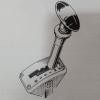Here we go again. Minis aren't metric.
The OP should have 1/8" toe in, but says that he has a metric 43 minutes
Is there a different angle measurement that anyone uses other than degrees/minutes/seconds for alignments? Should we be using radians?
1/8" or inches aren't an angle.
I guess in past times you'd measure the distance between the bulgiest part* of the left and right tyres, first at the front of the tyres, then at the back of the same tyres. The difference in lengths gives the toe "measurement". Since the angle was fixed by the manufactured shapes of the rear subframe and the arms it was, presumably, considered unadjustable so any discrepancy in the distance measurement (if anyone ever bothered to measure) would've probably been corrected - at least at a main dealer - by replacing those parts.
*Actually, at a given radius from the wheel centre, but I'm guessing (for 10" wheels at least) they're the same, specified that way for ease of measurement.
Now, we routinely check both sides separately and have ways of making adjustments, so measuring the total toe (L+R) isn't so helpful. Although the simple distance-difference between a fore-and-aft line (e.g. a string) and the bulgiest parts of the front and back of one tyre remains a good way to measure toe, so expressing it as a distance remains useful. The two distances (radius-from-centre (x2) and amount of toe) can be converted to an angle but if you're setting-up using a ruler and a string, it's not especially helpful to do this... so long as everyone uses the same radius-from-centre.
There seems - hardly surprising - frequent confusion whether the factory toe specification refers to one wheel, or the total of two wheels combined. This occurs irrespective of whether it's expressed as distance or angle. I remain uncertain myself on this and have to look it up every time I measure. But maybe that's just me and my old, old memory. It'd be great to have one pinned thread with a picture of what exactly the numbers should be at each wheel and how they can be measured-off against strings.
Even the workshop manual says that using angles is preferred. Angles have been used since about the 50s however equipment still displayed inches or mm. Probably because minutes are too confusing for the average person and "alignment technician"
Alignment data is usually clear as to being total or individual wheels, it is usually total as individual is just half. What can be confusing is the +/- symbols to indicate toe in/out. Older data is usually titled "toe in" due to vehicles all being RWD and in that case, the "-" indicates toe out. Newer data is usually labelled "toe" and therefore "+" means toe out and "-" means toe in.














